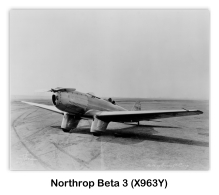

























Northrop Beta 3
Two-seat all-metal low-wing sport monoplane
Archive Photos
Northrop Beta 3, X963Y, c/n 1, mfg 4/4/1931 (Northrop)

Northrop Beta 3 Overview
- Type: Single-engine two-seat all-metal low-wing sport monoplane.
- Original Eng.: 165-hp Menasco Buccaneer 6 LAI #6010
- Wing span: 32 ft 0 in
- Wing area: 137 ft²
- Length: 21 ft 8 in
- Height: 6 ft 1 in
- Weight empty: 1,135 lbs
- Weight gross: 1,770 lbs
- Top speed: 175 mph
- Year built: 4/4/1931
- ATC: none
- Reg.: X963Y, c/n 1
- Comments: Crashed and destroyed on 8/12/1931
After the Northrop Alpha, the next design of the Northrop Aircraft Corporation was a trim low-wing all-metal two-seater. With private and personal aviation slowed by the onset of economic depression, it appears to have been a poor time to introduce a new plane "for the sportsman pilot." Still, there were some who had survived the stock-market crash and were willing and financially able to obtain the latest in airplanes just to fly for fun.
The new small tandem-seat Northrop plane continued to the Greek-letter sequence and was called the Beta. In another collaboration with Northrop, Al Menasco supplied one of his C-6 Buccaneer engines to power "the sportsman’s version of the Northrop Alpha." The planes monocoque fuselage faired neatly with the six-cylinder in-line engine. A special cowl, incorporating an air scoop, completely enclosed the 160-hp Menasco. The Beta’s clean lines and Alclad natural-metal skin, left unpaid, was enough to attract potential buyers at any airport. The shiny ship resembled a racer.
Test flights and evaluation trials were performed by Edmund T. Allen, long associated with the Boeing airplanes and the United Aircraft holding company. Allen made a fast run from Los Angeles to Salt Lake City and then onto Detroit in only 15 hours and 43 minutes flying time. Bundled in the open-cockpit ship, he cruised "the high altitude route" over the Rockies at 145 mph, and "with no effort." This performance and the subsequent exhibit of the plane at the Detroit Air Show caused a minor sensation.
On 8/12/1931, during a Department of Commerce certification flight, Lester J. Holoubek, the department’s resident inspector, took the shiny little Beta 3 up for a series of certification flights. During the flight, Holoubek had trouble with the ailerons and found the ship unmanageable. Allen had experienced the same problem during an earlier flight and was able to land the aircraft safely. However, unlike Allen, Holoubek had no great affection for the little airplane and elected to leave by parachute. The little Beta 3 augured itself into a Glendale hillside and was completely destroyed.
Northrop Beta 3 Specifications and Performance Data
Type
- Two-seat all-metal low-wing sport monoplane.
Wings
- Low-wing cantilever monoplane.
- Oval section structure, of monocoque construction.
- A smooth Alclad skin, with integrally-formed longitudinal stiffeners, carries the entire fuselage stresses.
- The structure is strengthened with ring-shaped bulkheads built up with a channel cross-section.
Fuselage
- Oval section structure, of monocoque construction.
- A smooth "Alclad" skin, with integrally-formed longitudinal stiffeners, carries the entire fuselage stresses.
- The structure is strengthened with ring-shaped bulkheads built up with a channel cross-section.
Tail Unit
- Normal monoplane type, entirely cantilever.
- Oval section structure, of monocoque construction.
- Smooth "Alclad" skin, with integrally-formed longitudinal stiffeners, carries the entire fuselage stresses.
- The structure is strengthened with ring-shaped bulkheads built up with a channel cross-section.
Undercarriage
- Divided type.
- Consists of two separate units, one under each wing-stub and enclosed in streamline "pants."
Power Plant
- One 160 hp Menasco Buccaneer six-cylinder in-line inverted air-cooled engine.
Accommodation
- Tandem open cockpits.
- Dual controls, with cables for operating all control surfaces.
Dimensions
- Wing span: 32 ft 0 in (9.7 m)
- Length: 21 ft 8 in (6.6 m)
- Height: 6 ft 1 in (1.8 m)
- Wing area: 137 ft² (12.7 m²)
Weights and Loadings:
- Weight empty: 1,135 lbs (515 kg)
- Pilot: 170 lbs (77 kg)
- Fuel and oil for 4 hours: 210 lbs (95 kg)
- Pay load: 255 lbs (116 kg)
- Weight loaded: 1,770 lbs (804 kg)
- Wing loading: 12.9 lbs/ft² (6.29 kg/m²)
- Power loading: 11.1 lbs/hp (5 kg/hp)
Performance (Estimated)
- Maximum speed: 175 mph (280 km/h)
- Cruising speed: 145 mph (232 km/h)
- Stalling speed: 48 mph (76.8 km/h)
- Initial rate of climb: 1,150 ft/min (351 m/min)
- Climb at 10,000 ft (3,050 m): 645 ft/min (197 m/min)
- Climb to 10,000 ft (3,050 m): 12.5 minutes
- Service ceiling: 22,700 ft (6,924 m)
- Absolute ceiling: 22,200 ft (6,771 m)
References
- Photos: Northrop photos from the Shupek Collection
- Grey, C. G., and Bridgman, Leonard, "Northrop: The Northrop Beta," Jane’s All The World’s Aircraft 1931, Sampson Low, Marston & Company, Ltd., London, 1931, pp. 304c
- Allen, Richard Sanders, The Northrop Story 1929-1939, Orion Books, New York, 1990, ISBN 0-517-56677-X, pp. 30-34,137,154-155.
































































